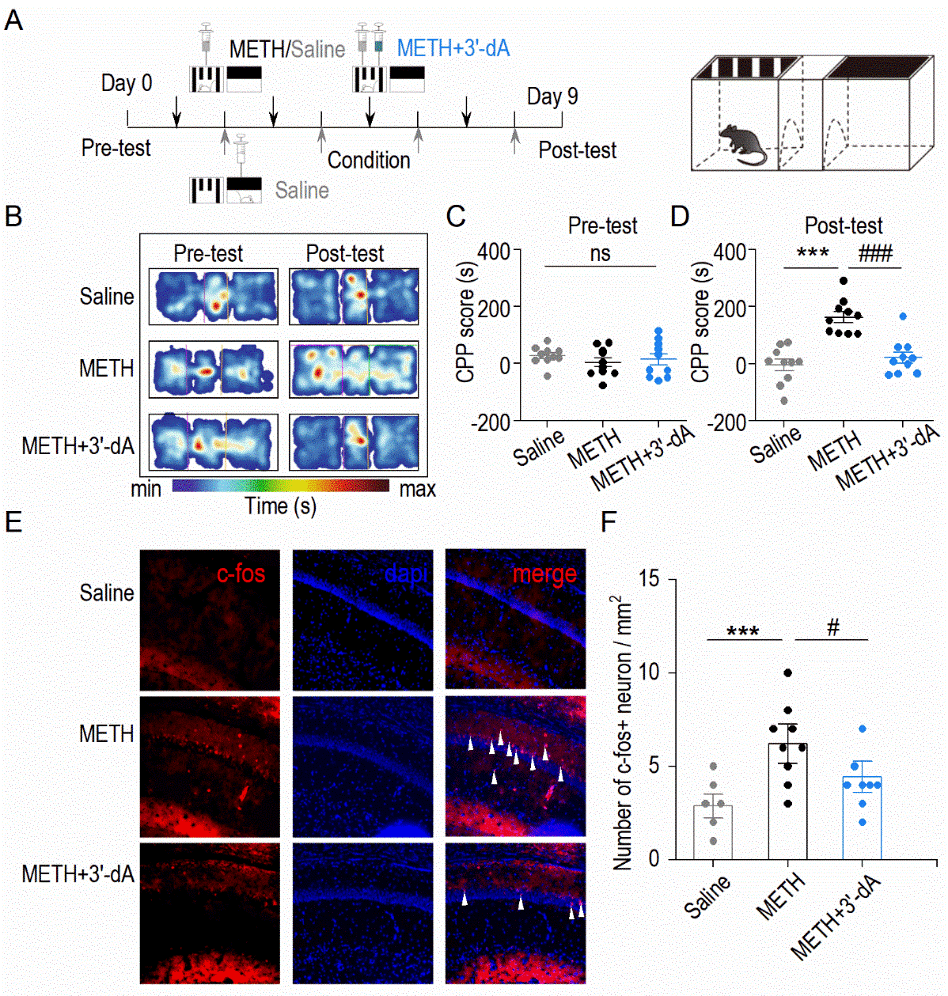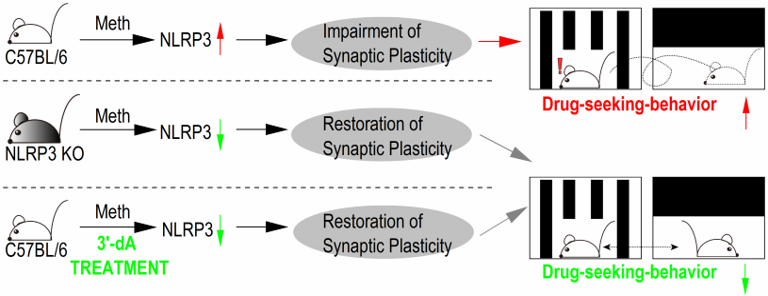NRR:南京医科大学马腾飞团队揭示3'-dA抑制NLRP3炎症小体作用减轻了甲基苯丙胺诱导的异常突触可塑性和渴求行为
撰写:齐一泽,周瑶,李继阳,祝方源,王灿,郭庚妮,余曼,汪义杰,马腾飞,冯善武,周丽
甲基苯丙胺(methamphetamine, METH)成瘾是一种慢性复发性脑疾病,强迫渴求行为是其特征性表现。研究发现,METH导致脑内神经元间的异常突触可塑性是该渴求行为的主要机制之一[1-2]。传统中药蛹虫草的主要生物活性成分3'-脱氧腺苷(3’-Deoxyadenosin, 3'-dA),可抑制NLRP3 (NOD-like receptor family pyrin domain containing-3)炎性小体在脑内的表达[3-5]。尽管既往研究已证实METH成瘾可激活NLRP3炎性小体的表达,但3'-dA是否通过抑制该炎性小体影响神经元异常突触可塑性并降低甲基苯丙胺渴求行为尚不明确。
南京医科大学马腾飞、冯善武和周丽团队在《中国神经再生研究(英文版)》(Neural Regeneration Research)2024年第10期发表的最新研究发现,3'-dA降低了METH成瘾小鼠的条件位置偏爱(Conditioned place preference,CPP)评分,并减少海马神经元中c-fos的表达。进一步研究证实,3'-dA可以降低METH引起的谷氨酸能突触传递的异常增强,并改善METH诱导的突触可塑性损伤。此外,3'-dA降低海马神经元中NLRP3的表达和改善海马神经元损伤。NLRP3敲除小鼠表现为METH渴求行为明显降低,突触可塑性及海马神经元损伤明显改善,表明NLRP3炎性小体在异常突触可塑性与METH渴求中的关键作用。最后,药理学方法激活NLRP3逆转了3'-dA对渴求行为和突触可塑性的影响。以上结果表明,3'-dA通过抑制NLRP3炎症小体来减轻METH诱导的异常突触可塑性和渴求行为,为甲基苯丙胺成瘾的治疗提供了新的治疗策略。齐一泽为论文第一作者,马腾飞教授,冯善武教授和周丽博士为论文共同通讯作者。
反复给予METH引起动物渴求行为且同时伴有脑内神经炎性因子表达水平异常升高[1-3],3'-dA是蛹虫草的有效成分,其具有明显的抗炎作用[4,5]。因此,实验首先从行为学和形态学两方面观察3'-dA是否对METH小鼠成瘾具有改善作用。METH成瘾小鼠CPP评分和c-fos表达明显升高,而3'-dA明显降低METH小鼠的CPP评分及海马神经元c-fos表达。这些结果表明,3’-dA明显改善METH小鼠的渴求行为,且减少海马神经元异常激活(图1)。以往研究显示,METH会导致谷氨酸能突触传递异常增强[6,7]。为了研究3'-dA是否影响METH诱导的谷氨酸能突触传递的改变,在行为测试结束后,测试海马神经元突触传递情况。作者发现3'-dA 降低了METH引起的AMPAR/NMDAR比值、AMPAR介导的输入输出曲线的异常升高。但3'-dA对配对脉冲比(Paired-pulse ratio, PPR)没有明显的影响,这些结果表明3'-dA可能通过突触后机制改善METH诱发的异常谷氨酸能突触传递的升高。
反复给予METH会损害正常认知记忆[8,9],作者研究发现3'-dA改善海马CA1 神经元长时程增强(Long-term potentiation, LTP)以及突触后记忆相关蛋白突触素(Spinophilin,SPN)和突触后致密部蛋白(PSD-95)表达显著降低,表明,3'-dA 可以缓解METH 引起的突触可塑性损伤。接下来,为了探究3'-dA是否减轻METH成瘾小鼠的神经炎症和神经元损伤,作者检测了海马NLRP3炎症小体的表达和海马CA1锥体神经元损伤情况。研究发现,3'-dA减少了METH诱导的NLRP3激活以及IL-1β和TNF-α介导的炎症反应,从而减轻海马神经元损伤。
为了进一步证明NLRP3炎性小体在METH成瘾行为中的作用,作者使用NLRP3敲除(knock out, KO)小鼠来验证神经炎症和突触可塑性之间的联系。研究发现,NLRP3 KO小鼠在给予METH后的CPP评分显著低于野生型(Wild type, WT)+METH组小鼠,表明NLPR3缺乏降低了小鼠的METH渴求行为。更进一步的研究发现,NLRP3 KO小鼠给予METH不影响fEPSP的斜率,表明NLRP3缺乏可减轻突触可塑性损伤。此外尼氏染色的结果也表明,与WT+METH组小鼠相比,NLRP3 KO+METH小鼠减轻海马CA1神经元损伤减轻。以上研究结果表明,NLPR3敲除减少了METH成瘾行为、神经元损伤和突触可塑性损伤,进一步证明NLRP3炎性小体介导异常的突触可塑性。为了明确3'-dA是通过抑制NLRP3炎性小体发挥其治疗METH渴求行为作用,作者在给予3'-dA治疗的同时给予NLRP3激动剂尼日利亚菌素(Nigericin,Nig)。实验结果发现Nig逆转了3'-dA对METH成瘾小鼠的治疗作用,表明3'-dA通过抑制NLRP3炎症小体,发挥其治疗METH渴求行为,缓解METH引发的突触可塑性损伤(图2)。

图1:3'-dA改善METH小鼠渴求行为并降低海马神经元的活性

图2:3'-dA通过抑制NLRP3炎症小体缓解甲基苯丙胺诱导的异常突触可塑性和渴求行为
总之,3’-dA在改善METH成瘾小鼠渴求行为方面具有重要作用。作者的研究表明,反复给予METH引起小鼠渴求行为,同时NLRP3炎性小体与海马神经元突触可塑性异常增强。3’-dA作为蛹虫草的有效成分,可明显抑制NLPR3炎性小体表达,改善海马神经元异常突触可塑性并降低METH小鼠的渴求行为。NLRP3敲除小鼠表现METH渴求行为降低及改善海马异常突触可塑性。此项研究为治疗METH成瘾提供了有效策略。

该研究也存在一定的局限性:此研究仅证实了NLRP3炎性小体在3’-dA改善METH渴求行为中的作用,但其下游信号通路,如caspase-1和含有caspase招募结构域的凋亡相关斑点样蛋白(ASC)的变化尚不清楚。进一步需要研究该信号通路在该模型中的变化及作用。此外,尽管作者的研究结果从NLRP3炎性小体方面揭示了3'-dA对METH诱导的异常突触可塑性的机制,但神经炎症其他方面的机制,如小胶质细胞的作用仍不清楚。因此进一步相关研究将深入围绕其他潜在神经炎症机制探索3'-dA 在METH成瘾中的作用。
原文链接:https://doi.org/10.4103/1673-5374.392887
参考文献
[1] Citri A, Malenka RC. Synaptic plasticity: multiple forms, functions, and mechanisms. Neuropsychopharmacology. 2008;33(1):18-41.
[2] Magee JC, Grienberger C. Synaptic plasticity forms and functions. Annu Rev Neurosci. 2020;43:95-117.
[3] Du SH, Qiao DF, Chen CX, et al. Toll-like receptor 4 mediates methamphetamine-induced neuroinflammation through Caspase-11 signaling pathway in astrocytes. Front Mol Neurosci. 2017;10:409.
[4] Yang WS, Kim JH, Jeong D, et al. 3-Deazaadenosine, an S-adenosylhomocysteine hydrolase inhibitor, attenuates lipopolysaccharide-induced inflammatory responses via inhibition of AP-1 and NF-kappaB signaling. Biochem Pharmacol. 2020;182:114264.
[5] Yang J, Zhou Y, Shi J. Cordycepin protects against acute pancreatitis by modulating NF-kappaB and NLRP3 inflammasome activation via AMPK. Life Sci. 2020;251:117645.
[6] Tokunaga M, Seneca N, Shin RM, et al. Neuroimaging and physiological evidence for involvement of glutamatergic transmission in regulation of the striatal dopaminergic system. J Neurosci. 2009;29:1887-1896.
[7] Luscher C, Malenka RC. Drug-evoked synaptic plasticity in addiction: from molecular changes to circuit remodeling. Neuron. 2011;69(4):650-663.
[8] Zheng Y, Reiner B, Liu J, et al. Methamphetamine augments HIV-1 gp120 inhibition of synaptic transmission and plasticity in rat hippocampal slices: Implications for methamphetamine exacerbation of HIV-associated neurocognitive disorders. Neurobiol Dis. 2022;168:105712.
[9] Reichel CM, Ramsey LA, Schwendt M, et al. Methamphetamine-induced changes in the object recognition memory circuit. Neuropharmacology. 2012;62(2):1119-1126.
#br#
马腾飞课题组全家福(照片提供自:马腾飞实验室)
该研究由国家自然科学基金面上项目资助,编号81971246(马腾飞);南京医科大学江苏省神经退行性疾病重点实验室开放基金课题资助,编号KF202204(周丽,冯善武)。齐一泽为论文第一作者,马腾飞教授,冯善武教授和周丽博士为论文共同通讯作者。


